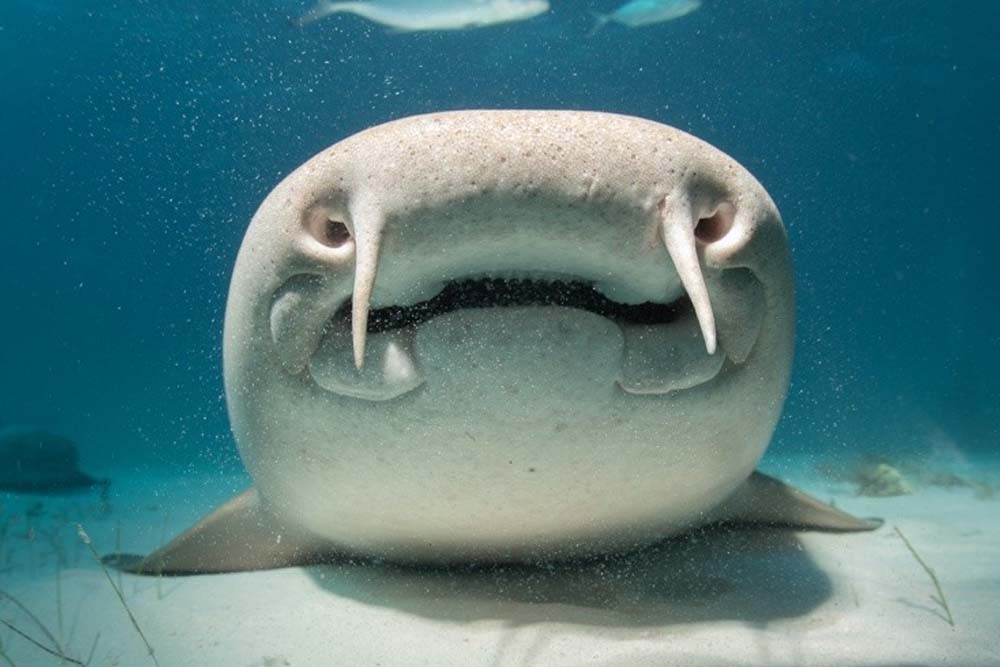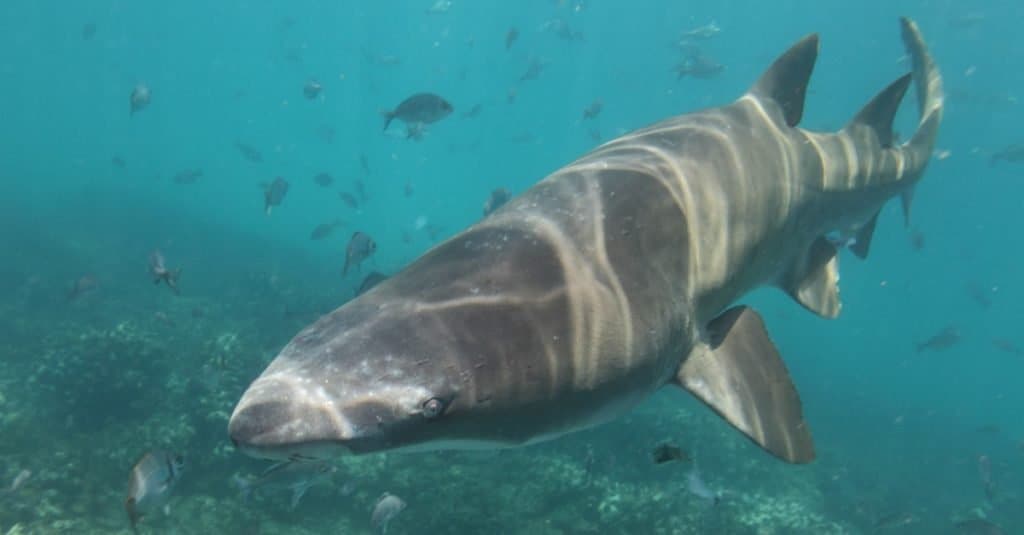Sharks are some of the best-known animals in the world due to their notorious reputation. They are cartilaginous fish, and they live in every ocean in the world. There are more than 500 species of shark alive today, and they come in a fascinating range of sizes and shapes. Some species are easier to distinguish than others, and – despite their name – when it comes to nurse sharks vs grey nurse sharks, there are actually quite a lot of differences between them.
In this article, we’ll discuss the key differences between nurse sharks and grey nurse sharks. We’ll compare their appearance, discuss their diet, and find out whether they migrate or not. We’ll even talk about how they reproduce and find out which one has babies who eat each other! So join us as we discover the differences between nurse sharks and grey nurse sharks!
Comparing Grey Nurse Shark vs Nurse Shark

| Nurse Shark | Grey Nurse Shark | |
|---|---|---|
| Species Name | Ginglymostoma cirratum | Carcharias taurus |
| Location | Western Atlantic and eastern Pacific oceans | Australia, North America, South America, Japan, South Africa |
| Habitat | Warm, shallow waters | Temperate and tropical waters around sandy shorelines, bays, and coral reefs |
| Size | Average up to 10ft 1in, largest approximately 14 feet | 6ft 6in to 10ft 5in |
| Appearance | Broad, rounded head, small mouth, two barbels between nostrils. Brown, flattened body with rounded dorsal and pectoral fins | Pointed head, flattened conical shaped snout. Mouth extends beyond the eyes. Stocky body, greyish-brown back with scattered reddish spots, pale underside |
| Teeth | Flattened, small and serrated | Needle like – long, narrow, and pointy |
| Offspring | 21 to 29 pups | 1 or 2 pups |
| Migrate | No | Yes |
| Diet | Small fish, stingrays, crustaceans, molluscs | Bony fish, smaller sharks, squid, stingrays, crustaceans |
| Hunting Method | Suction feeder | Grab and bite |
| Predators | Bull sharks, tiger sharks, lemon sharks | Adults – no natural predators Juveniles – great whites, bull sharks, tiger sharks, mako sharks |
The 4 Key Differences Between Nurse Sharks and Grey Nurse Sharks
The key differences between nurse sharks and grey nurse sharks are appearance, teeth, size, reproduction, habitat and location.
Nurse sharks and grey nurse sharks are both bottom-dwelling sharks that prefer warm waters around coastlines. Although their names suggest that they are a similar species, nurse sharks and grey nurse sharks are actually completely individual species. In fact, depending on their location, grey nurse sharks are sometimes more commonly called sand tiger sharks – given their liking for sandy shorelines. However, despite their name, they are not actually tiger sharks either! Their other common name is the spotted ragged-tooth shark.
Nurse Shark vs Grey Nurse Shark: Appearance

Nurse sharks have rounded snouts with two distinctive barbels near their nostrils.
©Maui Topical Images/Shutterstock.com
The most noticeable difference between nurse sharks and grey nurse sharks is their appearance. Nurse sharks have distinctly flattened bodies with broad, round heads and blunt snouts which have two barbels between the nostrils. They also have a small mouth that doesn’t extend beyond the eyes. Both their dorsal and pectoral fins are rounded. Nurse sharks are not a typical grey color but are pale to dark brown. Some individuals also have several dark spots on them.
Grey nurse sharks have stocky bodies with greyish-brown backs, scattered reddish spots, and a pale underside. They have a pointed head with a flattened, conical shaped snout. Their mouth also extends beyond the eyes.
Nurse Shark vs Grey Nurse Shark: Teeth
Some of the most important things to a shark are its teeth – because they use them to bite and grab their prey. But not every shark has the same type of teeth, and there are actually four different types of shark teeth.
Here the nurse shark and the grey nurse shark have very different teeth, and this is because they have different diets. Nurse sharks have the type of teeth that are known as “dense flattened teeth”. These teeth are small and flattened with small serrated edges. Flattened teeth are suited to the nurse sharks’ diet of small fish, crustaceans, and mollusks. This is because their flattened shape is useful for cracking open shells, and eating prey is tough. Nurse sharks also have a different method of feeding, which uses suction to pull their prey into their mouths.
However, the teeth of the grey nurse shark are known as “needle-like teeth”. This is because they are long, narrow, and pointy – and extremely sharp. These teeth are useful for grabbing small to medium sized fish, squid, and small sharks. This is because long and sharp teeth make it easier to hold onto fish with narrow bodies. They are also suited to the grey nurse sharks’ hunting method of grabbing and biting their prey.
Nurse Shark vs Grey Nurse Shark: Migration
Nurse sharks are a slow and sluggish species of shark, and they do not usually migrate or indeed travel very far. However, the same cannot be said about grey nurse sharks which are highly migratory and undertake an annual migration with a round trip of up to 1,900 miles (depending on location). Grey nurse shark migration is closely associated with reproduction. Each year, they mate in shallower water and then migrate towards warmer (and deeper) water to give birth. The young pups don’t undertake this migration and usually stay in deeper water until they mature.
Nurse Shark vs Grey Nurse Shark: Reproduction

Grey nurse shark pups eat each other before they are even born.
©Alessandro De Maddalena/Shutterstock.com
Although both nurse and grey nurse sharks are ovoviviparous, they are very different when reproducing. Nurse sharks give birth approximately every two years following a six month gestation period. They give birth to between 21 and 29 fully developed young, which are around 12 inches long.
Grey nurse sharks also give birth every two to three years, but they actually have one of the lowest reproductive rates amongst sharks. This is because of something called intrauterine cannibalism. Grey nurse sharks have two uterine horns, which initially contain around 50 embryos. When one embryo reaches approximately 4 inches long, it eats all of the other embryos that share its uterine horn. This is intrauterine cannibalism, and it leaves only one pup in each uterine horn. Two (or sometimes only one) pups are born after an eight to twelve month gestation period. The pups are around 3ft 3ins long, fully developed, and completely independent.
The photo featured at the top of this post is © Maui Topical Images/Shutterstock.com
FAQs (Frequently Asked Questions)
Are nurse sharks and grey nurse sharks related?
No, despite their name, nurse sharks and grey nurse sharks are not closely related. Nurse sharks are carpet sharks from the Orectolobiformes order and the Ginglymostomatidae family group. Grey nurse sharks are mackerel sharks from the Lamniformes order and the Odontaspididae family group.
What are the barbels on nurse sharks?
Nurse sharks have two distinct fleshy appendages located near their nostrils which are know as barbels. These are sensory organs that are thought to help them to detect prey on the sea floor.
Are grey nurse sharks dangerous to humans?
Despite their fearsome appearance grey nurse sharks are actually not considered to be dangerous to humans. Although they look frightening and dangerous with their mouthful of super sharp teeth on full display, they are relatively docile, non-aggressive sharks. However, like any animal, they can react if provoked, but there are no recorded fatalities.
Are nurse sharks dangerous to humans?
No, on the whole, nurse sharks are not dangerous to humans. They are typically slow moving sharks who spend the majority of their lives near the ocean floor. They rarely ever bother people. The exception being that if they are disturbed or stood on by divers then they can bite in self defense.
Thank you for reading! Have some feedback for us? Contact the AZ Animals editorial team.






